Stockton, California
It lies at the southeastern corner of a large inland river delta that isolates it from other nearby cities such as Sacramento and those of the San Francisco Bay Area.During the California Gold Rush, the San Joaquin River was navigable by ocean-going vessels, making Stockton a natural inland seaport and point of supply and departure for prospective gold-miners.He was born as Carl David Weber (February 18, 1814, in Steinwenden – May 4, 1881, in Stockton) and then went by Charles in 1836 in the United States, first spending time in New Orleans and then in Texas.He applied in Weber's place for Rancho Campo de los Franceses, a land grant of 11 square leagues on the east side of the San Joaquin River.Captain Weber's decision to change sides lost him a great deal of the trust he had built up among his Mexican business partners.[25] As the head of navigation on the San Joaquin River, the city grew rapidly as a miners' supply point during the Gold Rush.During its early years, Stockton was known by several names, including "Weberville," "Fat City," "Mudville" and "California's Sunrise Seaport.After the gold rush, many worked for the railroads and land reclamation projects in the Sacramento–San Joaquin River Delta and remained in Stockton.Early settlers included gold seekers from Asia, Africa, Australia, Europe, the Pacific Islands, Mexico and Canada.The historical population diversity is reflected in Stockton street names, architecture, numerous ethnic festivals and the faces and heritage of a majority of its citizens.On Thanksgiving Day, November 24, 1904, Holt successfully tested the first workable continuous track tread machine, plowing soggy San Joaquin Valley Delta farmland.[30] Company photographer Charles Clements was reported to have observed that the tractor crawled like a caterpillar, and Holt seized on the metaphor.[36] In 1933, the port was modernized, and the Stockton Deepwater Channel, which improved water passage to San Francisco Bay, was deepened and completed.Ruff and Ready Island Naval Supply Depot was established, placing Stockton in a strategic position during the Cold War.One of 15 temporary detention sites run by the Wartime Civilian Control Administration, the center held some 4,200 Japanese-Americans removed from their West Coast homes under Executive Order 9066, while they waited for transfer to more permanent and isolated camps in the interior of the country.In an attempt to prevent the further desecration of the burial grounds, a descendant of the people initiated a legal case which became Wana the Bear v. Community Construction (1982).Stockton's central location, relative to San Francisco and Sacramento, its proximity to the state and interstate freeway system, and its comparatively inexpensive land costs have prompted several companies to base their regional operations in the city.[45] Stockton's Weston Ranch neighborhood, a subdivision of modest tract homes built in the mid-1990s, had the worst foreclosure rate in the area according to ACORN, a now-defunct national advocacy group for low and moderate-income families.[56] Stockton's climate lies right on the boundary of, and fluctuates between, hot-summer Mediterranean (Köppen: Csa) and cool semi-arid (BSk).Stockton lies in the fertile heart of the California Mediterranean climate prairie delta, about equidistant from the Pacific Ocean and the Sierra Nevada.The racial makeup of Stockton was 108,044 (37.0%) white (22.1% non-Hispanic white[64]), 35,548 (12.2%) African American, 3,086 (1.1%) Native American, 62,716 (21.5%) Asian (7.2% Filipino, 3.5% Cambodian, 2.1% Vietnamese, 2.0% Hmong, 1.8% Chinese, 1.6% Indian, 1.0% Laotian, 0.6% Pakistani, 0.5% Japanese, 0.2% Korean, 0.1% Thai), 1,822 (0.6%) Pacific Islander (0.2% Samoan, 0.1% Tongan, 0.1% Guamanian), 60,332 (20.7%) from other races, and 20,159 (6.9%) from two or more races.The University of the Pacific Faye Spanos Concert Hall often hosts public performances, as does the Stockton Memorial Civic Auditorium.[96] The Ports have produced 244 Major League players including Gary Sheffield, Dan Plesac, Doug Jones, Pat Listach, and Stockton's own Dallas Braden among others.Later that day, Patrick Purdy, who was later found to be mentally ill, opened fire on the school's playground with a semi-automatic rifle, killing five children, all Cambodian or Vietnamese refugees, and wounding 29 others, and a teacher, before taking his own life.[112][113] On July 16, 2014, officers responded to an armed bank robbery, which resulted in the four perpetrators taking three hostages and leading them on an hour-long high-speed pursuit.The east–west highway State Route 4 also passes through the city, providing access to the San Francisco Bay Area as well as the Sierra Nevada and its foothills.The Stockton Diamond was the busiest interchange point in the state by 2020;[130] a grade separation project to elevate the Union Pacific over the BNSF line is planned to be completed by 2026.[citation needed] The Port of Stockton is a fully operating seaport approximately 75 nautical miles (86 mi; 139 km) east of the Golden Gate Bridge in San Francisco.Set on the San Joaquin River, the port operates a 4,200-acre (17 km2)[132] transportation center with berthing space for 17 vessels up to 900 feet (270 m) in length.[162] The indie rock band Pavement was formed in Stockton in 1989 by two local musicians, Stephen Malkmus and Scott Kannberg, known originally only as "S.M."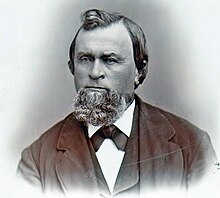






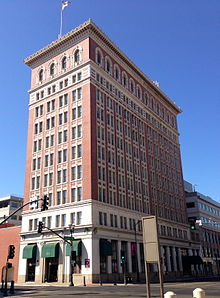

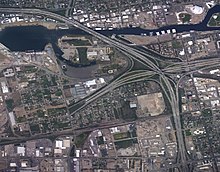
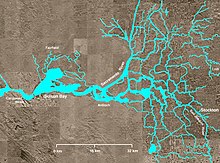
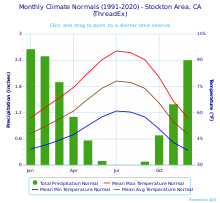


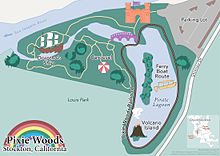

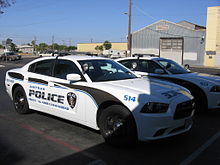
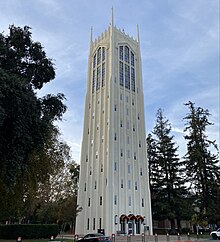
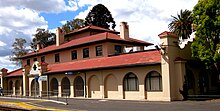
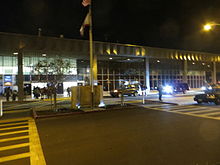

Fox TheatreUniversity of the PacificHotel StocktonCaliforniaSan Joaquin ValleyCountySan JoaquinIncorporatedNamed forRobert F. StocktonCity Manager-CouncilCity councilCity managerState senatorJerry McNerneyAssemblymemberRhodesia RansomUS: 101stUS: 76thDemonymTime zoneUTC−8PacificUTC−7ZIP CodesArea codecounty seatSan Joaquin CountyCentral ValleyU.S. state11th-most populous city60th-most populous cityUnited StatesAll-America CitySan Joaquin Riverlarge inland river deltaSacramentoSan Francisco Bay AreaCharles Maria WeberRancho Campo de los FrancesesCalifornia Gold Rushbankruptcyfringe benefits2008 financial crisisYokuts IndiansStockton ChannelSiskiyou TrailSacramento ValleyCascadesOregonMiwok IndiansSteinwendenNew OrleansBartleson-Bidwell PartyJohn SutterPueblo of San JoséMexicoleaguesMexican–American WarJosé Castrogold-seekersStockton - Los Angeles RoadCommodoreNative AmericanGuangdongSacramento–San Joaquin River DeltaChinese Exclusion ActMagnuson ActTranscontinental RailroadBenjamin HoltHolt Manufacturing CompanyErnest Dunlop Swintona British tankcontinuous track treadSan Joaquin Valley DeltaWorld War Igas–electric tankStockton Electric RailroadstreetcarsGurdwara Sahib StocktonSan Francisco BayRuff and Ready Island Naval Supply DepotCold WarGreat DepressionSpinach RiotWorld War IIWartime Civilian Control AdministrationJapanese-Americans removedExecutive Order 9066RohwerWana the Bear v. Community ConstructionethnocentrismBase Realignment and Closure CommissionfarmlandwaterwaysCalifornia DeltaInterstate 5State Route 99State Route 4Stockton Deepwater Shipping Channelinland sea portsUnited States Census Bureaumanufacturingshopping mallWeberstown MallSherwood MallStockton Metropolitan Airport2007 subprime mortgage financial crisisforeclosuresWeston Ranchhousing bubbleforeclosureForbescrime rateDetroitChapter 9 bankruptcyUnited States Bankruptcy Courtfederal bankruptcy judgeUniversal Basic IncomeChris Hugheshot-summer MediterraneanKöppencool semi-ariddiurnal temperature variationTule fogprairie